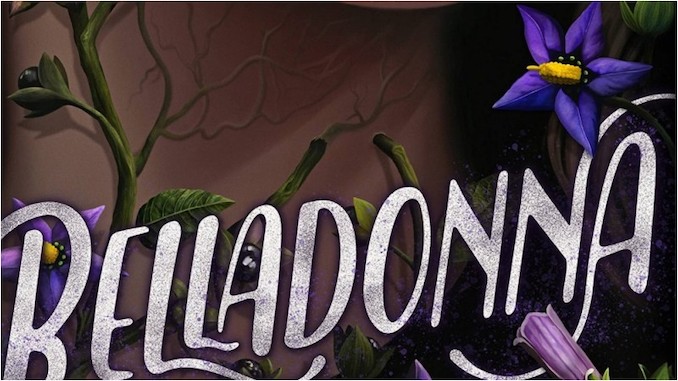
Adalyn Grace’s Belladonna is a hard novel to categorize. That’s meant as a compliment by the way, though it might not initially seem like one. The book sits at an intriguing crossroads within the world of publishing—a YA novel that deals with very adult themes like murder and sex, a Gothic romance that is also very clearly a coming-of-age tale about a young woman finally claiming her own power, both literally and figuratively.
It also occupies an intriguing liminal space in terms of the type of story it’s telling as well, mixing lush fantasy elements with a compelling murder mystery about a serial poisoner, as well as a swoony romance involving the literal personification of death. Yes, there are certainly moments where Belladonna can feel a bit overstuffed, like the story is struggling to balance its service to its many masters. But the book’s extremely unique blend of tropes ultimately mixes together to form an enjoyable, if unconventional treat.
Set in a magical version of Victorian England, it follows the story of Signa Farrow, an orphaned young woman who has spent much of her life haunted by death—both literally and figuratively speaking. Signa not only cannot die, but she is also able to see residents of the spirit world, from ghosts and unhappy spirits to Death himself.
Set to inherit a vast fortune when she reaches her majority, Signa’s been repeatedly shuffled between greedy relatives looking to use her money for their own ends. Unbeknownst to them, however, though the young woman’s unique connection with death means that she cannot die, those around her most certainly can, and each member of her string of guardians to date has met with an untimely end.
Her last remaining relatives are the eccentric Hawthorne family, which is how Signa finds herself moving into the gloomy estate known as Thorn Grove. Patriarch Elijah is morning his recently deceased wife Lillian, eldest son Percy is trying to convince his father to let him take over the family business, and daughter Blythe appears to be suffering from the same mysterious illness that killed her mother. But when Lilian’s spirit tells Signa that her death was no accident, she finds herself at the heart of a murder mystery where it feels as though everyone she meets could well be a suspect.
Part of the reason for that is simply because everyone feels like a suspect. Perhaps it’s due to the book’s vaguely spooky Gothic vibes, but the setting seems to gild every character with dark emotions and shady motives. While most people will likely come to this novel for its romance elements or autumnal read-under-a-blanket-with-tea aesthetic, the specifics of the story’s murder mystery are actually quite well done, with plenty of red herrings, unexpected twists, and surprise character reveals.
Signa is helped along in her investigation by two men with murky agendas of their own—Silas, a mysterious stable boy who works for the Hawthorne family, and Death himself, who, as it turns out, has essentially been watching over Signa for years. (She’s developed a bizarre habit of basically killing herself with belladonna berries so that she can force him to interact with her, the psychological ramifications of which I do wish the story had spent a bit more time on.) The idea of falling in love with death has a long history in fiction, and Belladonna doesn’t break any new ground here in that regard. What is interesting is the way that Grace grounds Signa’s growing attraction to Death in her larger coming-of-age story, both in terms of her burgeoning understanding of sexual desire and her slowly shifting realization of what sort of woman she wants to become.
Having spent much of her life isolated and ostracized, Signa initially longs for nothing more than a normal place in society. She very much wants to participate in all the things she’s been shut out from up until this point: Balls, afternoon teas, and other traditional forms of Victorian-era social rituals. But as she actually experiences more of the world she spent so long wanting to be a part of, she slowly begins to wonder if being a proper young lady is worth giving up her ability to think independently and make her own choices.
Her obvious attraction to Death (the ultimate in bad boys, after all) is only a small part of that story. And Grace smartly remembers to at least somewhat reckon with Signa’s privilege in being able to make these choices in the first place—the fact of her wealth means she doesn’t have to do things she doesn’t want to do or accept a subpar match for the sake of her own survival, a situation that would have been…let’s just say fairly abnormal for the period.
Grace’s debut All the Stars and Teeth duology (which is also great and you should read it) was most notable for the array of complicated female characters present in its high seas adventure, from a princess determined to make herself worthy of the throne she’s set to inherit to a fierce mermaid out for revenge. Belladonna continues that trend, offering up a lead heroine who is equal parts reckless, brave, loyal, and foolhardy.
Desperate for everything life has to offer after years of lack, Signa finds herself enjoying the things her handy ladies’ guidebook to beauty and etiquette says a well-bred young woman doesn’t indulge in, from food to flirtation. But as she slowly begins to realize that there’s nothing wrong with being an independent woman who thinks for herself, she finds her inner steel. A second murder closes the novel and opens the door to a sequel, and I’m pretty sure I won’t be the only one waiting to find out where Signa’s story goes next.
Lacy Baugher Milas is the Books Editor at Paste Magazine, but loves nerding out about all sorts of pop culture. You can find her on Twitter @LacyMB.